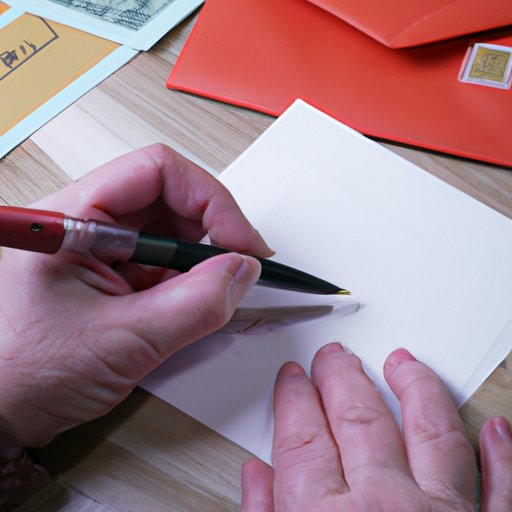
Introduction
Writing on envelopes is something that we do almost daily, yet it’s often taken for granted. Many people don’t give it much thought and end up making common mistakes. However, getting it right is important because it can make the difference between your letter arriving safely or getting lost in the mail. In this article, we’re going to explore the dos and don’ts of writing on envelopes, proper addressing techniques, crafting the perfect envelope, the importance of neat handwriting, and common mistakes to avoid.
The Dos and Don’ts of Writing on Envelopes
When writing on envelopes, there are several mistakes that people make. One of the most common mistakes is using the wrong pen. Use a pen that doesn’t smudge or bleed. Another mistake is writing either too small or too large, which can make it difficult for the postal workers to read the address. To make it easier for the postal worker to know where to deliver your envelope, use proper spacing between lines and words. Finally, don’t forget to correctly place the return address on the envelope. The return address should be written at the top left corner of the envelope.
To avoid making these mistakes, it’s important to use neat and legible handwriting. Use a writing style that you’re comfortable with but make sure to keep it tidy and consistent throughout the envelope.
How to Properly Address an Envelope: A Step-by-Step Guide
Addressing an envelope is easy if you follow the correct steps. First, write the recipient’s name in the center of the envelope. Next, add their street address to the line below their name. The city, state, and zip code should be written on the next line, respectively.
On the top left corner of the envelope, write your return address. Make sure to include your name, address, city, state, and zip code. That way, the postal worker can easily return the letter to you in case there’s an issue.
To ensure that your addressed envelope is perfect, use a ruler or other straight edge to line up all the writing. This will make it easier for the postal worker to find the address, and also add a professional look to your letter.
Crafting the Perfect Envelope: Tips for Addressing and Decorating
A plain white envelope might be functional, but it isn’t exactly eye-catching. Adding color and decorations can make it stand out in the mailbox and bring a smile to the recipient’s face. Try using different ink colors, such as blue or green, instead of the standard black. You can also add a personal touch by adding stickers, drawings, or other fun designs.
Make sure that the decorations don’t interfere with the address area of the envelope. Keep the decoration to a minimum and confined to the edges.
When it comes to addressing the envelope, consider personalizing it based on the recipient or occasion. For example, if you’re sending a letter to a child, you can use a fun font or add colorful stickers. If you’re sending a formal letter, use a more professional tone and keep the decorations to a minimum.
The Importance of Neat Handwriting on Envelopes: A Practical Guide
Neat handwriting is essential when writing on envelopes, especially when it comes to formal or official correspondence. It’s important to make sure that the handwriting on the envelope is easily readable. If postal workers can’t read the writing, your letter might get delayed or lost.
There are several tools and techniques available to improve your handwriting. Consider investing in a good quality pen with a comfortable grip. Use a pencil to lightly sketch out the words before using a pen to write on the envelope. Keep your letters consistent in size and shape. And practice your handwriting regularly to improve its quality.
Common Mistakes to Avoid When Writing on Envelopes
Aside from the aforementioned mistakes, there are other common issues to watch out for when writing on envelopes. Don’t write illegibly, as it will make it difficult for the postal worker to read the address. Another mistake is not adding enough postage, causing delays in delivering your letter. Finally, make sure to double-check that the address is correct. Addressing the envelope incorrectly may cause your letter to get lost or delayed in the mail.
Writing on Envelopes Made Easy: Essential Tips for Beginners
Writing on envelopes is an essential skill that everyone should know. In summary, avoid common mistakes such as using the wrong pen and writing too small or too big. Follow the correct steps for addressing an envelope and use neat handwriting. Make sure to avoid adding too many decorations but adding some personal touches can bring a smile to the recipient’s face. Finally, always double-check your work before sending it to avoid mistakes.
With these essential tips, anyone, even beginners, can be confident when writing on envelopes and make sure their letters get to their destination on time and in good condition.
Conclusion
Writing on envelopes might seem like a small part of sending a letter, but it’s an important one that shouldn’t be ignored. By following the tips and techniques discussed here, anyone can write a clear and eye-catching envelope. Remember, clear and legible handwriting is key, and adding a few personal touches can make your letter stand out in the mailbox.





